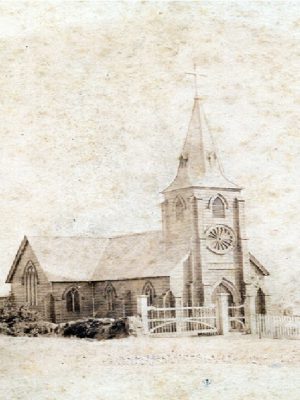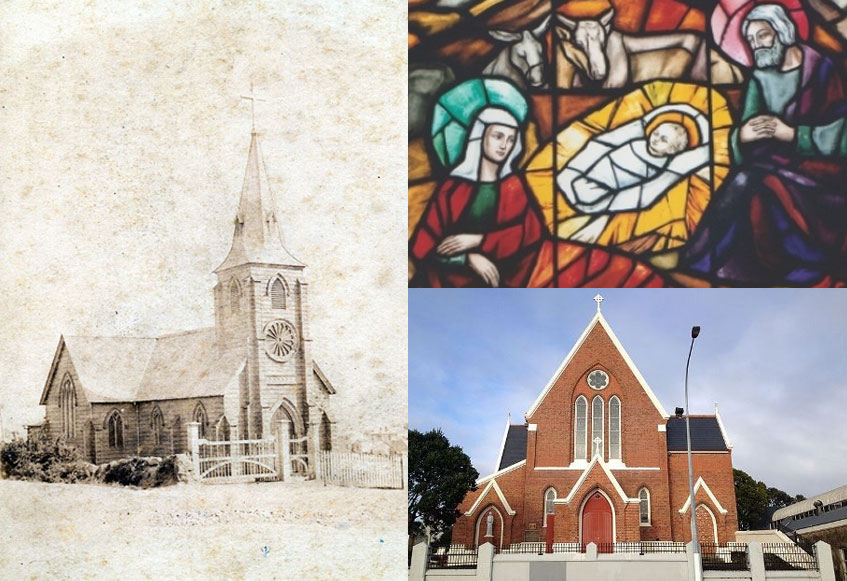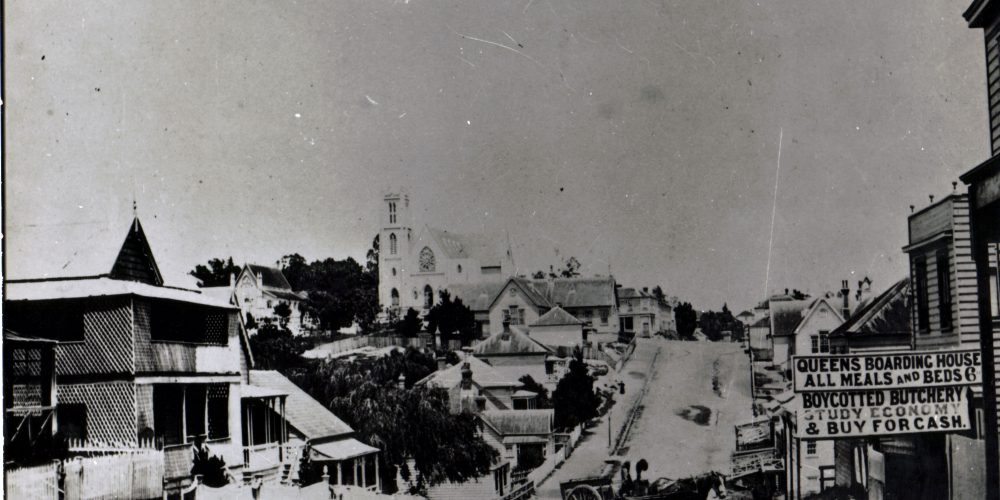History & Priests

In 1866 Bishop Pompallier blessed and opened the small wooden Church of St Francis de Sales for the convenience of his parishioners living in the Newton area.
It stood in the corner of the East (now Alex Evans) street and Symonds Street in the Catholic Cemetery (first blessed in 1844 and situated opposite the present Church, where the motorway now runs).It was used as a Mortuary Chapel as well as a Mass center, with a priest coming from the Cathedral. No seats were ever installed.

Arrival of the Benedictines
When Bishop Steins SJ ( recently retired from the Diocese of Bombay, India) was named Bishop of Auckland in 1879, there were only fourteen priests in the whole Diocese. So he asked the Benedictine monks at Ramsgate, England if they could provide staff. Fathers Downey, O’Gara and Vaggioli (author of a history of New Zealand), accompanied by two lay brothers, arrived that same year and were given charge of the newly created Newton Parish.
At that time, Auckland’s population was 60,000 and Newton had 2,000 parishioners. The Parish’s boundaries stretched to the west and included the present Parishes of Grey Lynn, Pt. Chevalier, Mt Roskill, Mt Albert, Balmoral, Avondale, Epsom, and Henderson.B
Fr Cuthbert Downey OSB was named Parish Priest. The Parish was so badly in debt that he turned the presbytery into a boarding house. Men slept on beds, couches and even on the floor in every room.
The Benedictine Fathers were also made responsible for managing the Pitt St boy’s school although a lay teacher did the actual teaching. This school was handed over to the Marist Brothers in 1886 to become the first Sacred Heart College in Auckland.
Bishop Stein resigned because of ill health in 1881 and Edmund Luck OSB was appointed Bishop. By now there were seven Benedictines in the Diocese.
First St Benedict’s Church

In May 1880 a meeting of parishioners of St Francis de Sales was called to
discuss the building of a new Church. Land was bought from the Auckland City Council for £1,150 . The Architects E. Mahoney & Sons were commissioned to design the Church. As Auckland had no Bishop at this time, the Vicar-Capitular, Very Reverend H J Fynes, laid the foundation stone on September 10th 1881. This first St Benedict’s Church was blessed and opened by Bishop Redwood on July 23, 1882.The building had cost nearly £6,000 and was probably the largest wooden Church in New Zealand at that time.
According to the NZ Herald, it comfortably seated 1200 people.
“The consecration and opening services of St Benedict’s Church, Newton, took place yesterday, and were attended with every circumstance that could render them impressive. The spacious Church was crowded with 2000 being present at each service.” (NZ Herald July 24 1882).
Fr. Francis (Augustine) Luck OSB, in charge of the Kihikihi Mission and brother of
newly-appointed Bishop Edmund Luck OSB, built a beautiful altar from native
timbers.
The Church was designed to have two towers but only one was built. This had
four stages, the topmost being an observatory for Fr O’ Gara, a Fellow of the
Royal Astronomical society.
The stage immediately beneath housed the church bells. The main entrance was surmounted by a great rose window. There were side chapels and sacristies and an internal stair case led down to the large crypt.
However, the final cost of the Church was about double the original contract price and the Building Committee had to ask the neighbouring congregations and non-Catholic friends to help pay the outstanding amount.

On the night of December 13, 1886, a house in Upper Queen Street caught fire.
The flames spread to neighboring houses and then were carried by the wind to
the wooden shingled roof of St. Benedict’s. There was no way of dealing with such a large fire. Eventually, the whole Church and the priest’s house were destroyed. The Cross on St Francis de Sales’ Chapel also caught alight, but that building itself was saved.
Within two weeks the parishioners- men, women, and children – had built a temporary Church on the corner of the street and so were able to continue with Sunday Mass (This structure was later incorporated into the Parish Hall and young men’s club room. The foundation stone was laid in 1898).
All that can still be seen of the first St Benedict’s is the stone retaining wall in the north end of the present hall. Fr O’Sullivan OSB, with Messrs. P. Brophy, T. H. White, Thomas Mahoney and Lieutenant – Colonel Mahon formed a building committee. J. J. Holland was engaged as a builder.
E. Mahoney & Sons were again commissioned to design the new Church, but this time in durable brick and with a roof of English slate.Although the parishioners worked hard at fundraising, the new Church had to be much plainer than the first. The design called for one tower, but this was never built. And instead of a rose window, three tall narrow windows surmounted by a small rose were installed above the main door.
There was insufficient money to build the planned Sanctuary so a temporary one was built of galvanized iron. It was to last until 1954. The new brick Church – the present building- was blessed and opened by Bishop Luck OSB on April 22, 1888. Archbishop Redwood was again in attendance and preached at both morning and evening services.
However, the altar used was the humble one burrowed from St Francis de Sales Chapel, as Fr Francis Luck did not finish his second magnificent altar and reredos until 1893. Fr Downey, assisted by other Benedictines, continued as a Parish Priest until his sudden death in 1895.
St Benedict’s about 1990
The Benedictine priests who served at St Benedict’s were: 1889 superior Adalbert O’ Sullivan succeeded by Fr Wissel, then Osmund Egan. Lord abbot Alcock lived there 1881-1882 was noted for his preaching which drew large crowds.
Other priests who were in the parish at this time included father Downey, Fox, Luck, Fagioli, O’Gara, Mandolin and Gregory De Groote.
Bishop Luck OSB hoped that the Auckland Diocese would become a permanent
Benedictine responsibility but his superiors declined this offer and after Fr Downey died in 1895, they gradually withdrew all their staff.
At no time during their sojourn in New Zealand were the Monks able to live
according to the rules of the Monastic Order to which they had dedicated their
lives. In 1900 Bishop Lenihan made St Benedict’s again a Diocesan responsibility.
Diocesan Parish Priests
- 1899 -1921 Monsignor George Gillan
- 1921-1929 James Liston – While Co-Adjustor Bishop
- 1930-1949 W. J .Ormond
- 1950-1976 A. H. Hyde
- 1976-1981 Fr Francis Xavier Brown OP
- 1981-1985 Fr Aquinas Mccomb OP
- 1985-1989 Fr David Halstead OP
- 1989-1991 Fr Tom Cassidy OP
- 1991-2001 Fr Peter Murnane OP
- 2001-2002 Fr Paul Rankin OP
- 2002-2005 Fr Bernard Dennehy
- 2005-2009 Monsignor Bernard Kiely
- 2009-2020 Monsignor Paul Farmer
- 2021 Fr Andrew Matthew
- 2022 Fr Mario Dorado OFMCap
- 2023-Present Fr Gilbert Ramos
Monsignor George Gillan - (1899 -1922)
In 1899 the English-born George Gillan was named Parish Priest and served, with Secular Curates, until 1921. As well as his Parochial duties he was Vicar General from 1906 and Administrator of the Diocese between the death of Bishop Lenihan (1910) and the accession of Bishop Cleary.
According to Fr E R Simmons, Monsignor George Gillan was a vigorous pastor, paying off old debts, caring for the school, providing and adding the wrought- iron railings to the front and side of the church.He arranged for the purchase of the brick presbytery (built by Benedictines in 1887).
One way of raising the money necessary for all this, and for the growing schools across the Street was through bazaars.
These were often two-week-long events held in the Parish hall with items performed by the school pupils, adult tug-of- war competitions and much socialising. Stalls such as refreshments, the children of Mary’s Surrey Hills and lollies-&-flowers were staffed by women from throughout the large Parish and all were dutifully named in the preprinted programme. The Curates, notably Fr Forde and Fr E McLaughlin, were very involved.
During Monsignor Gillan’s time, Churches were built at Grey Lynn (1914), Balmoral and Avondale (1921) and subsequently these became independent parishes.
On Monsignor Gillan’s retirement in 1921 the New Zealand born James Michael Liston, at that time Co-Adjustor Bishop of Auckland, became Parish Priest, assisted by Monsignor Ormond as Administrator.
Bishop J M Liston D D - Parish Priest (1921-1929)
During this time, the fourth anniversary of the first celebration of Mass in the brick Church was commemorated. Also, during this period St Benedict’s became noted for its music, due to the presence of Signor Constantini, a former conductor of the Sistine Chapel Choir.
The stained glass windows in the nave were installed and the present pews provided.
While at St Benedict’s, the future Archbishop began his life-long interest in the University Catholic Society.
When Bishop Cleary died in 1929, Bishop Liston left St Benedict’s to take on responsibility for the whole Diocese.
Monsignor W. J Ormond - Parish Priest (1930-1949)
The Administrator under Bishop Liston, New Zealander Monsignor W. J Ormond, was in charge from 1930-1949. He was noted for his piety, his strong character and his leadership qualities. He was respected by all. Sadly, he was very ill for the last five years of his life.
During these last years, the Parish was administered by Fathers Doyle and W. Ryan. The latter – in conjunction with the Architect C. Reginald Ford- had the Baptistery and Font, with its enclosing wrought- iron gates, erected and arranged for new decoration throughout, including fluorescent lighting and linoleum covering of the floors. Successful bazaars raised money for the Parish and schools.
Monsignor A. H. Hyde (1950 - 1976)
In 1950 New Zealand- born Father A.H.Hyde became Parish Priest – the first Auckland- ordained Priest to do so. He was active in building.
In 1950 he added the present brick porch at the front of the Church and in 1955 he arranged for the building of the new and larger Sanctuary – to replace the temporary one of 1888.
Next came the adjoining Lady Chapel, into which was moved Fr Francis Luck’s altar, unsuitable now that the Priest said Mass facing the people.
(The magnificent reredos is thought to have been damaged by borer to the extent that it was not preserved. Borer also damaged beyond salvation all but one of the original Stations of the Cross from the original Church furnishings.)
A handsome new altar of Hanmer marble was presented by Mr and Mrs T. Shannahan, and the Baldachino was erected above. New Sacristies and two reception rooms were added and a corridor built to provide direct, internal access to the Presbytery.
Mr C. Reginald Ford was again the Architect, with H. J. Short Ltd doing the building. The Curates in 1956 were Fr W. Ryan , Fr T. F. Hogan and Fr F.McHale.
The altar was consecrated by Archbishop Liston on December 22, 1955. It incorporated the relics of St Benedict, St Vincent de Paul, St Pius X, St Peter Chanel, St Faustinus and St Marcellin Champagnat. When Monsignor Hyde reached 70 years of age in 1976, he resigned and went to Devonport Parish. He was remembered as “ the people’s priest”.
Dominican Responsibility
In 1976, Bishop John Mackey invited the Dominican Priests to take over the running of St Benedict’s, in exchange for their Parish of St. Dominic’s at Blockhouse Bay.
Fr. Batten was Superior, Fr Francis Xavier Brown became Parish Priest on February 2, 1976 and Fr Placid Nolan was in charge of Hospital Chaplaincies. Soon Br John Swinkles arrived to provide St Martin de Pores devotional supplies. (Devotion to this Saint had been centred on the Parish from the time of his Canonisation in the 1960s). Fr Esmond Klimeck chose the Parish as the Centre of his Rosary Crusade.
Fr Ambrose Loughlan became Chaplain to the University. Fr David Halstead moved between Dunedin and Auckland Universities until being named Vicar Provincial and Parish Priest of St Benedict’s. Fr Nolan returned to Ireland and was succeeded by Fr Joseph Parkinson as Hospital Chaplain. Fr Aquinas McComb arrived in 1981, acting as Parish Priest until 1985 when he went to USA for higher studies. Fr Christopher Loughlan arrived in 1981 as Librarian, Hospital Chaplain and with Third Order (Dominican Laity) responsibilities. He was elected Prior in 1982. Fr Bernard Williams arrived in 1986.
F. X. Brown (1976- 1981)
Known as “FX” he instituted 7 Sunday Masses on the hour – more than any other City Church. He gave popular courses on the Scriptures. In 1980 he uncovered the time capsule buried in 1887 by Bishop Luck then arranged for the installation of the commemorative plaques of past Parish priests on front wall.
He also installed the Shrine in honour of St Martin de Porres. In 1980 F.X.Brown began work on the crypt – a rough space beneath the main nave in the same unfinished condition that builders had left it in 1888.
Aquinas McComb
Aquinas McComb furnished the northern half of the hall as a Chapel (doing much of the work with his own hands). The old Altar rails, removed from the Sanctuary were used to shield the stairway installed in the East transept.
Bernard Williams, in 1987, had the southern half (the space created below the half Sanctuary) enclosed and fitted as a suite of offices and the remainder of the original hall became the Dominican Library.
Book St Benedict’s Parish
Whether it’s a wedding, a reunion, holiday celebration or other special occasion, our team and facilities make each event unique and memorable.

